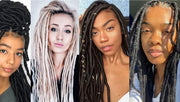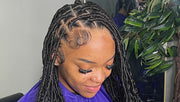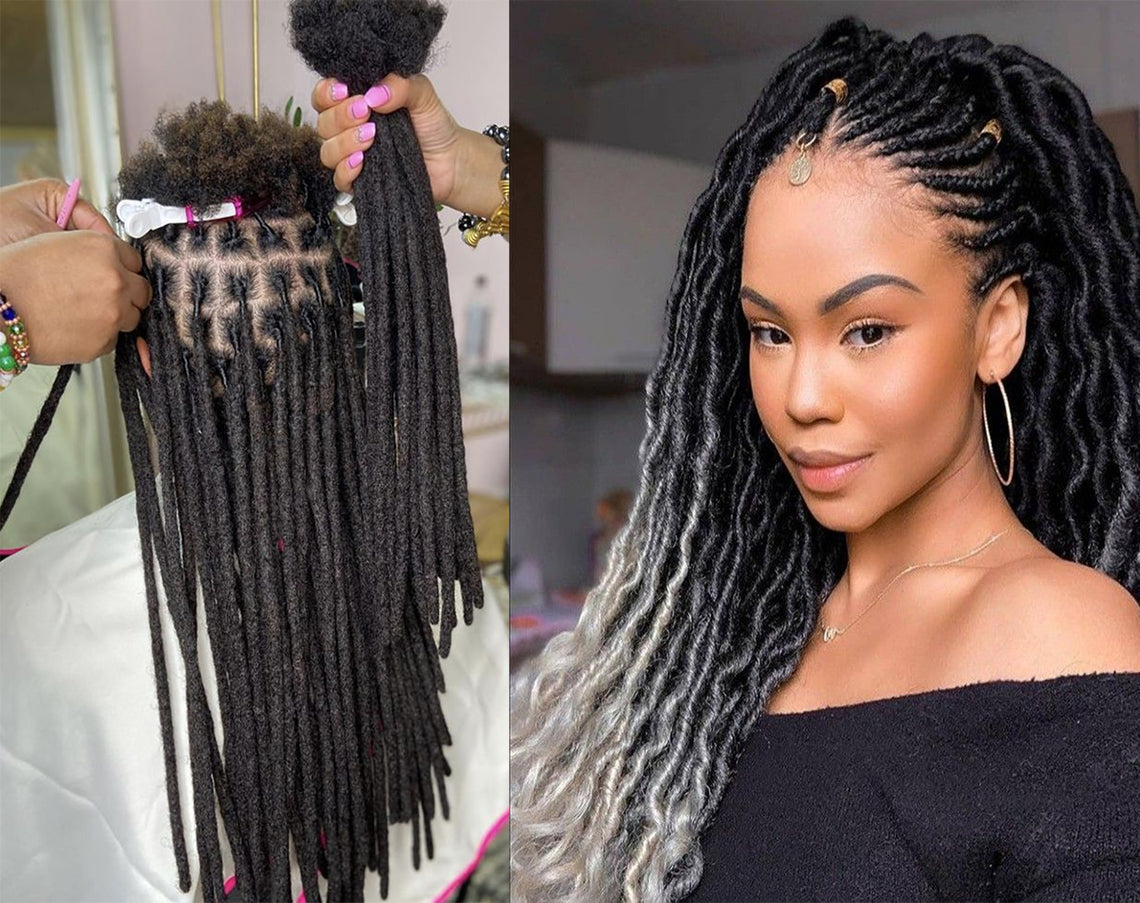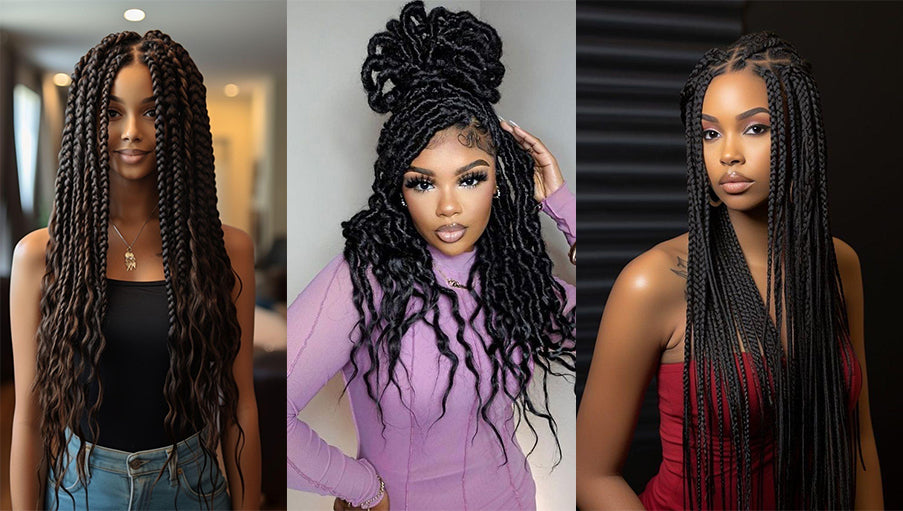What are Dreadlocks?
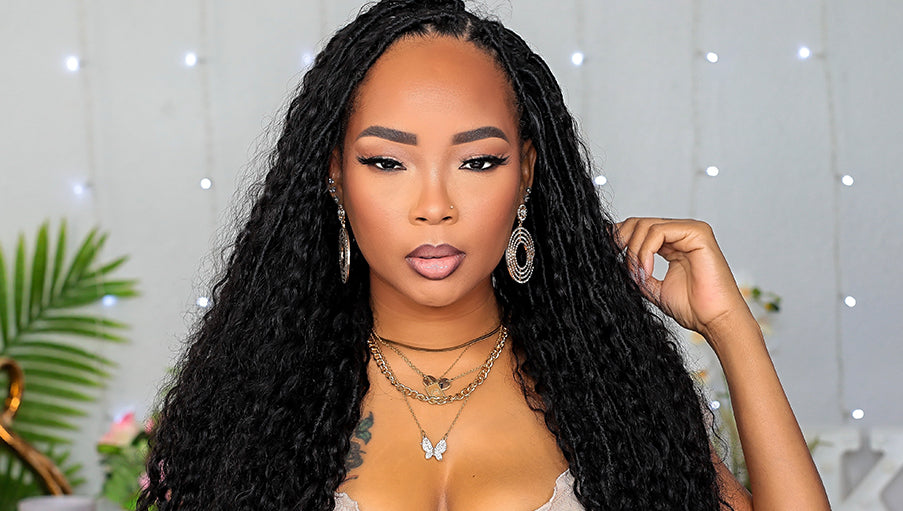
Dreadlocks, also known as locs, are a unique hairstyle that will make anyone stand out from the crowd. In fact, I've heard people say that dreads have helped them improve their self-esteem.
One beautiful thing about dreadlocks is their cultural and historical background. If you are someone who, aside from their looks, values, culture and historical facts, then this hairstyle is something you should consider.

What are Dreadlocks?
Dreadlocks are matted ropelike strands of hair that can be made into various sizes using different methods. But more on that later.
The hairstyle looks as though it requires less maintenance, which is true to a certain extent. Especially when you can forget about spending that extra 1-2 hours in the morning on your hair just to make it look good.
But in order to ensure your dreadlocks look healthy, you have to take care of them regularly. And one of the ways is going to see a loctician for touchups and re-crocheting.
History of Dreadlocks
Dreadlocks have a history that stretches back thousands of years. Various cultures have embraced dreadlocks for reasons such, as beliefs. Others to symbolize prestige and resilience.
For generations diverse African communities have proudly worn dreadlocks as a reflection of their heritage.
One example is the warriors of Kenya, known for their red dreadlocks colored with natural earth pigments. In Egypt mummies were unearthed with traces of dreadlocks indicating the long presence of this style in their heritage.
Turning towards Asia dreadlocks have been linked to religious customs. In India dreadlocks are commonly sported by Sadhus or holy men symbolizing their detachment from concerns and worldly attachments. Within Hinduism dreadlocks are seen as a representation of enlightenment and an indifference towards appearance.
In the 20th century dreadlocks gained popularity in the Caribbean through the Rastafari movement. For Rastafarians dreadlocks signify their connection to their roots and resistance against influences. They are also viewed as adherence, to a decree known as the Nazarite Vow of Separation.
Dreads vs Locs
The terms "dreads" and "locs" are used based on cultural perspectives and beliefs.
Dreads are believed to have originated from the Rastafari movement.
During this trend the locks were viewed as "intense" by controlling groups representing the wearers courage and defiance of standards.
Locs have become a term to describe the hairstyle without using the word "dread." Locs are often used to highlight the beauty and cultural importance of this hairstyle.

How to Begin a Locs Hairstyle
There are four methods, for initiating a Locs Hairstyle. Each method suits different hair types, lengths and personal preferences.
Comb Coils
Comb coils is suitable for short to medium hair lengths. Works well on hair with tighter curls. This technique involves twisting sections of hair around itself using a comb, forming coils. As these coils mature they start to interlock. Resulting in a consistent look for the initial locs stage.
Palm Rolling
Palm rolling is a method employed to stimulate matting during ongoing stages of loc formation. It entails sections of hair between your palms, from roots to ends.This technique is commonly used alongside methods like comb coils to maintain the shape and promote the locking process. Palm rolling is effective, for all hair types and lengths contributing to the formation of a cylindrical loc shape.
Braids or 2-Strand Twists
Braids or two strand twists are a way to start locs that suits any hair texture and length. This method involves dividing the hair into sections and then braiding (with three strands) or twisting (with two strands) each section. Over time these braids or twists will naturally begin to Lock. This approach is popular due to its simplicity do it yourself nature and ability to maintain an appearance during the hairs transition into locs.
Organic/Freeform
The organic or freeform method represents the main route to developing locs. It involves allowing the hair to mat and lock on its own over time without interference. This method includes washing and separating the hair to prevent sections from merging into mats that are hard to manage. Freeform locs are unique, for each person as they naturally lock in their pattern and size reflecting an individual's journey. This approach is admired for showcasing beauty and individuality.

Locs Hairstyle Stages
Understanding the stages of styling your locs can offer insights and motivation as you observe the evolution of your hair over time.
Starter Stage (Lasting Three to Six Months)
The initial phase marks the start of your loc journey. During this period your hair may be styled into comb coils, two-strand twists, braids, or left to naturally form sections. These early styles lay the groundwork, for your future locs. It's a stage where your hair begins to adapt to its shape requiring gentle care, especially during washing to preserve the initial sections. This phase is filled with excitement and anticipation as you begin to see the indications of locking.
Budding Stage (Six to 12 Months)
The Budding Stage is where the magic starts unfolding. You'll notice buds or swellings forming along your sections indicating that the hair is beginning to interlock and mat internally. This phase is crucial as it signals that your hair is responding well to the locking process. The texture of your locs will gradually change, becoming more structured as they mature. Patience plays a role during this stage since the appearance of your locs may seem uneven and slightly frizzy.
Teen Stage (From Month Up To 15th)
During this phase of loc development your hair begins to showcase its character. This period is marked by growth and progression. Your locs may start to hang or sway as they lengthen and gain weight indicating that they are moving beyond the phases of formation. However, the teen stage can still involve some frizziness and irregularity as your locs continue to mature.
Mature Stage (From 15 to Month 18)
As your locs reach the stage (from 15 to around 18 months) they acquire a defined shape, with reduced frizz. Each loc is now tightly interlocked. The pattern from your styling method becomes less prominent. Your maintenance routine might evolve during this phase since your locs are now resilient enough to endure washing and grooming practices. Many individuals perceive this stage as when their locs have reached their potential showcasing the complete beauty and strength of this hairstyle.
Rooted Locs Stage (From Month 18 to Month 21)
Transitioning into the rooted locs stage (from around 18 to 21 months) it signifies that your locs have fully matured. The locs are firmly set in place with an internal structure and a smooth exterior surface. Taking care of locs at this stage is more about keeping them healthy and looking good than forcing them to lock.

Different Types of Locs Hairstyles
Each type of locs hairstyle has its features, upkeep needs and visual appeal.
Sisterlocks
Sisterlocks, a hairstyle by Dr. JoAnne Cornwell consist of thin locs that require a special tool and technique for installation. These locs are versatile allowing different styling options making them a popular choice for those who desire flexibility in their hairstyles.
Traditional Locs
Also known as dreadlocks are medium strands typically started with comb coils, two strand twists or palm rolling. These locs come in different lengths and thicknesses while embodying the timeless essence of the classic loc style.
Semi-Freeform Locs
Semi-freeform locs find a balance between groomed and natural growth patterns. Those opting for this style may initiate their loc journey using a method. Then let the locs grow with minimal interference only occasionally twisting the roots. This approach offers a look while still maintaining some control, over how the locs take shape.
Freeform Locs
When it comes to locs they are created with no interference. The hair is left to intertwine and form locs on its own with individuals needing to separate them. This style is admired for its simplicity and the distinctive organic appearance it brings about as each loc develops based on the natural growth pattern of the hair.
Instant Locs
Instant locs are form using tools, like a crochet hook to shape the hair into locs in one session. This technique is perfect for those looking to skip the phases of the loc journey and achieve a look right away. Quick locs can be done on any hair textures and lengths.
Microlocs
Microlocs are very small often resembling braids or twists in size. They can be initiated using methods such as twists, interlocking or even Sisterlocks. This style is versatile, providing an intricate and refined appearance compared to conventional locs.
Two-strand Twist Dreads/Locs
Initiating dreadlocks through two-strand twists involves twisting two hair sections. Over time these twists will form dreadlocks.
This technique is well-liked for its simplicity and the appearance it gives creating a pattern and style, for locs.
Interlocking Locs
Interlocking is a method used to maintain locs by tightening the roots. It involves pulling the end of each loc through the root to ensure it stays secure. This approach can also be utilized to initiate locs on all hair types offering a sturdy and easy-to-manage look.
Related Reading: What Are the Different Types of Dreadlocks?

Time to Install
The time required to install locs varies depending on the chosen method, hair length and thickness and desired loc size. For instance, Sisterlocks installation can take up to 24 hours due to its detailing and small size. Traditional and instant locs may take anywhere from hours to a day. Conversely freeform locs do not have an installation timeframe. Instead, they develop naturally over time.
Cost
The cost of starting locs varies based on the method chosen, the expertise of the professional, and the service location. Sisterlocks typically fall in the higher price range due to their installation process costing around $500 to $800 or more. Traditional loc installations may range from $100 to $300.
Regular upkeep sessions, which are essential, for all types of locs except freeform also contribute to the long-term cost. It's crucial to have a conversation about pricing with a stylist or loctician in advance to fully grasp the investment required.
How Long Do Locs Last?
With care and attention locs can last indefinitely. They are a long term commitment and often become a permanent hairstyle. The enduring nature of locs is one of their qualities as they continue to mature and adapt alongside the individual. Consistent maintenance and adopting hair care routines are vital for sustaining resilient locs over time.

How Often Should You Retwist Your Locs Hairstyle
The frequency of retwisting or maintenance sessions varies based on your hairs growth rate, the chosen loc method and personal preferences regarding appearance. Typically its recommended to retwist every 4 to 8 weeks for individuals seeking a look while promoting loc growth. On the other hand individuals with freeform locs may opt for less hair manipulation only separating at the roots as needed. However, it's essential to listen to your hairs requirements and adjust your upkeep routine accordingly for beautiful locs.
Related Reading: How Often Should You Retwist Your Locs?
How to Maintain Locs
Caring for your locs is essential to maintain their health, look and durability. While specific care routines can vary based on the type of locs and individual preferences the basics involve washing, moisturizing and occasional retwisting or grooming to keep them tidy and prevent tangling at the roots. It's also crucial to protect your locs at night and avoiding hairstyles that create tension. By caring for your locs you ensure they stay strong, fresh and vibrant.
Related Reading: How to Take Care of Dreadlocks?
FAQ
How Do You Sleep with Dreads?
Sleeping with dreadlocks requires some preparation to preserve their condition and appearance. The key is to safeguard them from friction and tangling. Many individuals wrap their dreads in a silk or satin scarf/pillowcase to reduce friction minimizing the chances of breakage. Another option is to tie your dreads on top of your head while sleeping to prevent tangles as you move around.
How Do You Keep Dreadlocks Clean?
Maintaining dreadlocks is vital, for their health and appearance. Despite beliefs, it's important to wash dreadlocks. The frequency of washing may vary depending on your lifestyle, hair type, and personal choice. Generally, it's recommended to wash every 1 to 3 weeks.
Related Reading: How to Get Rid of Buildup in Dreadlocks?


